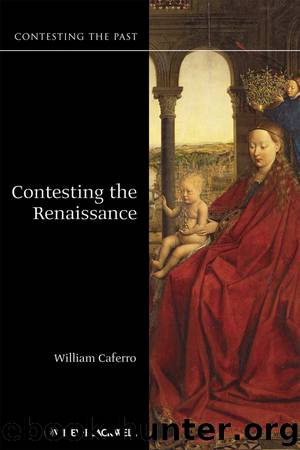Contesting the Renaissance by William Caferro

Author:William Caferro
Language: eng
Format: epub
Publisher: John Wiley & Sons
Published: 2010-08-05T16:00:00+00:00
Imitation as Innovation
Consideration of humanism in its diverse settings makes more difficult any attempt to posit a single workable definition for it. If, as Eugene Rice has suggested, Jacques Lefèvre d’Étaples was a representative humanist figure in France, he does fit easily within the definition of humanism as a rhetorical and philological enterprise. Lefèvre’s interests included religious speculation and philosophy. The same is true of the Dutch humanist Justus Lipsius, who undertook a philological reconstruction of the work of Seneca, which engendered in him interest of the poet’s stoic philosophy.
The contradictions are not at once at odds with Kristeller’s famous definition of humanism, which is not so narrow as some critics maintain. Kristeller allowed humanism an indirect and powerful influence on philosophy.85 But discomfort remains over where precisely to draw the line. Textbooks and general studies, whatever explicit definition they give of humanism (and it is usually Kristeller’s) often include philosophers in the discussion. They do so by distinguishing between those who were humanists proper and those who were inspired by humanism. In his survey of Italian developments, George Holmes included Marsilio Ficino and Giovanni Pico della Mirandola as part of a “second phase” of humanism.86 But Holmes took care to call the men, and those in their circle, “humanist inspired” rather than humanists. Charles Nauert’s recent textbook explicitly denies Ficino the title of humanist, but includes him in the discussion of Florentine humanism, by means of subheading, that at once sets him apart, but allows reference to his ideas and influence. In her textbook, The Renaissance in Europe, Margaret King treats humanism in a chapter entitled “Human Dignity and Humanist Studies: The Career of Humanism (1350–1530),” a heading that maintains a basic distinction between Ficino and Pico (grouped under “Human Dignity”) and the humanists, but facilitates discussion of the two trends together.87
The approach reflects a basic methodological problem. It is difficult to offer a broad history of humanism that is inclusive of Northern European developments without reference to Ficino and Pico, who had such a profound influence beyond the Alps. As we have seen, many of the major northern figures studied with them and took up their interest in Plato and Neoplatonic thought. Moreover their notion of “human dignity” provides a unifying feature of the Renaissance intellectual ethic that seems well applied to both the pursuit of eloquence as well as to philosophical speculations. It was, as De Lamar Jensen states in his textbook, the “philosophical phase” represented by Ficino and Pico that had “something to offer to northern humanists” and thus “propelled” humanism across the Alps. Eugene Rice used the term “humanist philosophy of man,” which remains popular in textbooks.88
Nevertheless the unity implicit in the notion of human dignity is more illusory than real. The Florentine humanist Gianozzo Manetti (1396–1459) asserted the importance of the dignity of man in his eponymous, On the Dignity and Excellence of Man. But he positioned his argument against the slights to human dignity in medieval literature, particularly in the work of Pope
Download
This site does not store any files on its server. We only index and link to content provided by other sites. Please contact the content providers to delete copyright contents if any and email us, we'll remove relevant links or contents immediately.
| Archaeology | Essays |
| Historical Geography | Historical Maps |
| Historiography | Reference |
| Study & Teaching |
Underground: A Human History of the Worlds Beneath Our Feet by Will Hunt(12025)
Sapiens by Yuval Noah Harari(5294)
Navigation and Map Reading by K Andrew(5111)
The Sympathizer by Viet Thanh Nguyen(4306)
Barron's AP Biology by Goldberg M.S. Deborah T(4100)
5 Steps to a 5 AP U.S. History, 2010-2011 Edition (5 Steps to a 5 on the Advanced Placement Examinations Series) by Armstrong Stephen(3690)
Three Women by Lisa Taddeo(3354)
Water by Ian Miller(3129)
The Comedians: Drunks, Thieves, Scoundrels, and the History of American Comedy by Nesteroff Kliph(3039)
Drugs Unlimited by Mike Power(2545)
A Short History of Drunkenness by Forsyth Mark(2234)
DarkMarket by Misha Glenny(2160)
The House of Government by Slezkine Yuri(2159)
And the Band Played On by Randy Shilts(2130)
The Library Book by Susan Orlean(2042)
Revived (Cat Patrick) by Cat Patrick(1963)
The Woman Who Smashed Codes by Jason Fagone(1929)
Birth by Tina Cassidy(1864)
The Absolutely True Diary of a Part-Time Indian by Sherman Alexie(1859)
